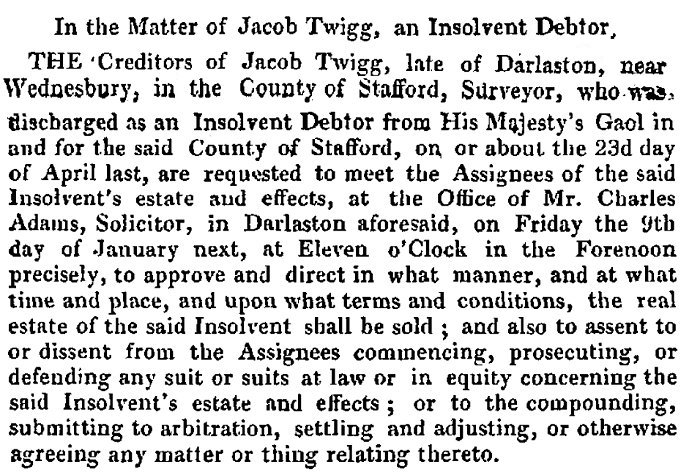|
Phil Clayton, who is researching
the BCN has kindly informed me that the engineer in
charge of building James Bridge Aqueduct was
Samuel Bull, who
was responsible for much of the BCN’s work at the time,
along with James Bough, the Company’s ’Superintendent’
who died the year before the aqueduct was completed.
Phil comments that it’s often the consulting engineer
who gets the credit for works rather than the company’s
men who actually carried out the work.
Jacob Twigg
The Walsall Canal from Broadwaters
to Walsall was built by Jacob Twigg and Joseph Smith, in
two parts. The first part from Broadwaters to Darlaston
had been completed by May 1798. The company and their
engineer, Mr. Hood, were happy with the standard of the
work and so a second contract to build the canal to
Walsall was issued to Twigg and Smith in April 1798. The work was to be
completed by January 1799, but work on the wharf at
Walsall did not begin until after 1800.
Jacob Twigg is described as a land
surveyor in W. Parson and T. Bradshaw’s Staffordshire
General and Commercial Directory for 1818. He lived at
Bar Croft in Darlaston and did much of the construction
work on the Birmingham Canal. He was given the contract
for the cutting of the Toll End Branch in March 1800 and
also worked on the Bilston Canal and the Willenhall
Branch.
In 1824 he successfully tendered
for the canal branch at West Bromwich, known as the
Ridgeacre Cutting, easily beating the competition by
bidding over £1,000 less. He was later allowed to
increase his tender by £150 to pay for the hire of boats
to remove the spoil. By December 1824, little progress
had been made and the canal company’s surveyor and civil
engineer, Thomas
Telford, who had been engaged in March of that year,
thought that spoil could be removed faster and more
efficiently with a tramway.
Although a tramway was built,
little work on the Ridgeacre Branch took place. Jacob
Twigg complained about quicksand in some areas, but the
canal company had had enough and decided that he had
been negligent and had broken his contract. He was
replaced by Hyde and Jackson, who had put-in the second
cheapest tender for the work. In September 1825 Jacob
Twigg was dismissed as an engineer to the BCN but was
unable to find sufficient work elsewhere. He was
declared to be an insolvent debtor and as such was
imprisoned at Stafford. In those days an insolvent
debtor could be kept indefinitely in a debtors’ prison
if the creditors so wished. Imprisonment for debt didn't
end until 1869.

From The London Gazette, December
23rd, 1828.
In 1833, Jacob Twigg’s property in
Darlaston was auctioned off. This was a sad end to such
an initially promising career. |